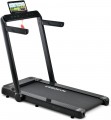Min. running speed
The slowest speed at which the treadmill belt can move. This parameter is indicated only for
electric models (see "Load system"), as in other types, it depends solely on the user himself.
The ability to operate the belt at a low speed is important if strong loads are contraindicated — for example, during the rehabilitation period after injuries. In many modern models, this figure is only 1 km/h (even though the average walking speed of a healthy person is about 5 km/h). Thus, they can be used even with serious injuries, when normal walking is very difficult.
Training programs
The number of
training programs provided for in the design of the simulator. This is not about load levels, but about automatic modes of operation, during which the belt can change the speed of movement, signal the beginning and end of a workout, etc. For details on the number of programs, see Programs and information.
Running belt size (LxW)
Under the dimensions of the belt in the specs of treadmills, they usually mean the dimensions of the working area — that is, the running deck within which the user's feet stay during training. Several points determine the optimal length and width of the belt.
The long treadmill length ensures safety — less likely to seriously stumble and fall out of rhythm. On the other hand, a long belt requires a more powerful motor, and the dimensions of the treadmills increase accordingly. With all this in mind, it is believed that the optimal length for home use is 120 – 130 cm; longer belts are designed for use in fitness centres and professional training.
Both safety and comfort when using the treadmill also depend on the width of the belt. This parameter is especially important for people of large build — on a narrow canvas, they can be “cramped”. On the other hand, as in the case of length, a large width means a large size of the treadmill itself. In general, entry-level models have a belt up to 40 cm, in more advanced treadmills there are options for 45 cm, and for professional use, this figure can reach 50 cm.
When choosing a treadmill according to the size of the belt, it is best not only to take into account all of the above, but also to try out the option that interests you before making a purchase. After all, a lot depends on personal characteristics and preferences, and a seemingly suitable treadmill may be small — or vice versa, a more...compact and inexpensive option is quite suitable.
Dimensions
The dimensions of the treadmill in the assembled state. It is important to note that more space is needed for the comfortable and proper operation of the treadmill.
Weight
The total weight of the treadmill when assembled.
All such treadmills are quite massive — models weighing up to 50 kg are considered
light. And when choosing, it is worth considering that both small and significant weight have their advantages. So, lightweight designs are more convenient when moving, while weighty ones are more stable, often have more extensive functionality, and are also better suited for people with large body weight.

